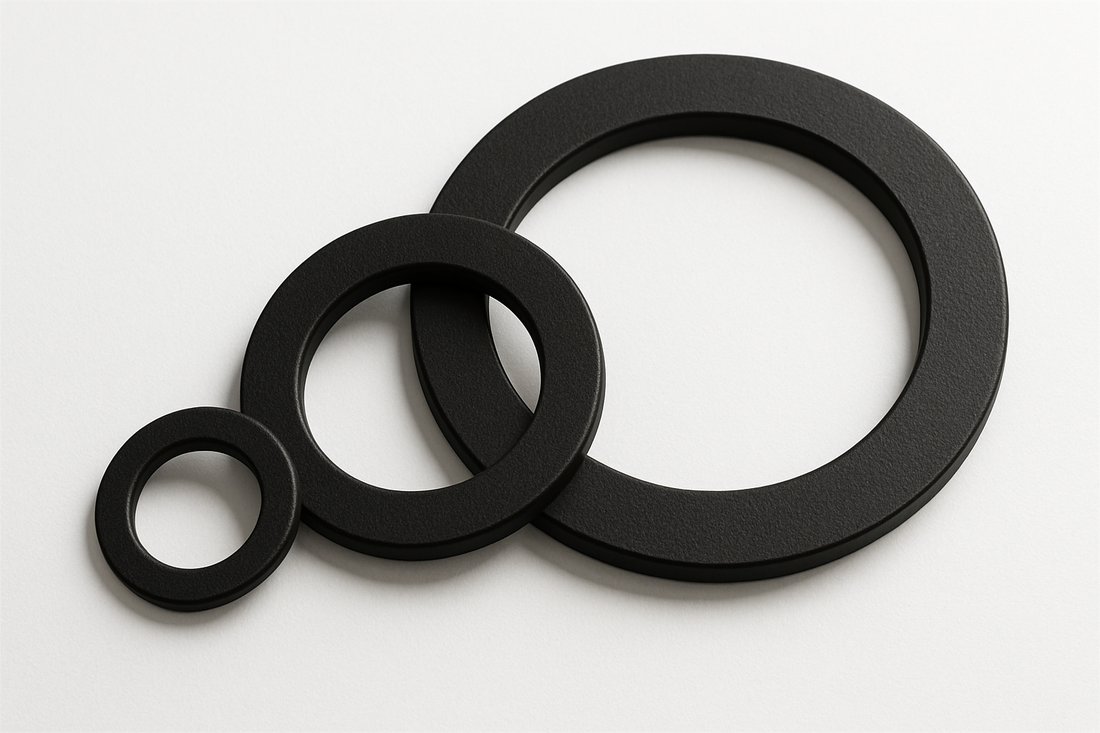
What is Nitrile Rubber: The Complete Guide to NBR Material Properties and Applications
Share
Introduction
Nitrile rubber stands as one of the most versatile and widely used synthetic rubber materials in industrial applications today. Known for its exceptional oil resistance and mechanical durability, nitrile rubber has become the material of choice for gaskets, seals, and various rubber components across automotive, oil and gas, and manufacturing industries.
Whether you're an engineer specifying materials for a new project, a maintenance manager sourcing replacement gaskets, or a procurement professional evaluating rubber material options, understanding nitrile rubber's properties, applications, and limitations is essential for making informed decisions. This comprehensive guide covers everything you need to know about nitrile rubber, from its basic properties to technical specifications and purchasing considerations.
What is Nitrile Rubber?
Nitrile rubber is a synthetic rubber compound created through the polymerization of acrylonitrile and butadiene. This oil-resistant elastomer offers excellent resistance to petroleum-based oils, fuels, and hydraulic fluids while maintaining good mechanical properties across a wide temperature range. Nitrile rubber typically operates effectively in temperatures ranging from -40°F to 250°F (-40°C to 121°C), making it suitable for diverse industrial applications.
The material's unique molecular structure provides superior resistance to swelling and degradation when exposed to oils, greases, and many industrial chemicals. This combination of oil resistance, durability, and availability in various formulations has made nitrile rubber a standard choice for sealing applications in industries where petroleum products are present.
Alternative Names for Nitrile Rubber
Nitrile rubber is known by several names and abbreviations in the industry, which can sometimes cause confusion when sourcing materials. Understanding these alternative names ensures you're getting the correct material for your application:
NBR (Nitrile Butadiene Rubber):
The most common technical abbreviation used in specifications and material data sheets.
Buna-N:
A trade name originally developed by Bayer, now commonly used as a generic term for nitrile rubber.
Buna:
Sometimes used as a shortened version of Buna-N, though this can occasionally refer to other synthetic rubbers.
Acrylonitrile Butadiene Rubber:
The full chemical name, typically used in technical documentation and material safety data sheets.
When ordering nitrile rubber materials or specifying them in drawings, any of these terms will typically be understood by rubber suppliers, though NBR and Buna-N are the most commonly accepted industry terms.
Key Properties and Advantages of Nitrile Rubber
Nitrile rubber offers several advantages that make it the preferred choice for many industrial sealing applications:
Excellent Oil and Fuel Resistance: Nitrile rubber maintains its properties when exposed to petroleum-based oils, gasoline, diesel fuel, hydraulic fluids, and many lubricants. This resistance prevents swelling, softening, and degradation that occurs with natural rubber materials.
Good Mechanical Properties: NBR exhibits excellent tensile strength, tear resistance, and abrasion resistance, providing durability in demanding applications.
Wide Temperature Range: Operating effectively from -40°F to 250°F, nitrile rubber performs well in both cold and moderately high-temperature environments.
Chemical Compatibility: Beyond oils, nitrile rubber resists many aliphatic hydrocarbons, water, and some acids and bases, making it versatile for various chemical environments.
Cost-Effective Solution: Nitrile rubber offers excellent performance-to-cost ratio compared to specialty elastomers, making it economical for high-volume applications.
Common Applications for Nitrile Rubber
Nitrile rubber's unique properties make it ideal for numerous industrial applications:
Automotive Industry: Engine gaskets, transmission seals, fuel system components, O-rings, and hydraulic system seals.
Oil and Gas Industry: Pipeline gaskets, pump seals, valve gaskets, wellhead seals, and drilling equipment components.
Manufacturing and Industrial: Hydraulic system seals, pneumatic components, conveyor belt applications, and general machinery gaskets.
Marine Applications: Engine room gaskets, fuel system seals, and hydraulic components where oil resistance is critical.
Food Processing: FDA-grade nitrile formulations for applications requiring oil resistance combined with food safety compliance.
Limitations and Unsuitable Environments
While nitrile rubber excels in many applications, certain environments and conditions can cause performance issues:
Ozone and Weather Exposure: Standard nitrile rubber has poor resistance to ozone and UV light, leading to cracking and degradation in outdoor applications. EPDM rubber is typically preferred for weather sealing applications.
High-Temperature Limitations: While nitrile handles moderate temperatures well, applications above 250°F require specialty high-temperature elastomers like Viton or silicone rubber.
Strong Acids and Bases: Concentrated acids and strong caustic solutions can attack nitrile rubber, requiring chemical-resistant materials like PTFE or specialized rubber compounds.
Ketones and Esters: Certain solvents, including acetone and many esters, cause nitrile rubber to swell and degrade rapidly.
Steam and Hot Water: Extended exposure to steam or hot water above 200°F can cause nitrile rubber to degrade, making EPDM a better choice for hot water applications.
Types of Nitrile Rubber Available
Nitrile rubber comes in various formulations to meet specific application requirements:
Standard NBR: General-purpose nitrile rubber suitable for most oil-resistant sealing applications.
Cloth Inserted Nitrile: Fabric-reinforced nitrile sheets that provide increased tear resistance and dimensional stability for large gasket applications.
Diaphragm Grade Nitrile: Specially formulated for flexibility and fatigue resistance in pumping and valve applications.
FDA-Grade Nitrile: Food-safe formulations that meet FDA requirements for food contact applications while maintaining oil resistance.
Peroxide-Cured Nitrile: Superior heat resistance and compression set properties for high-temperature applications within nitrile's operating range.
Temperature Range and Operating Conditions
Nitrile rubber operates effectively across a temperature range of -40°F to 250°F (-40°C to 121°C), with optimal performance typically occurring between 0°F and 200°F. At low temperatures, nitrile rubber maintains flexibility better than many other oil-resistant elastomers. At elevated temperatures, the material maintains its sealing properties while resisting thermal degradation.
For applications approaching the upper temperature limits, consider peroxide-cured formulations or evaluate whether Viton might provide better long-term performance. For extremely low-temperature applications below -40°F, specialty low-temperature nitrile compounds are available.
Chemical Compatibility
Nitrile rubber demonstrates excellent compatibility with petroleum-based products including motor oils, hydraulic fluids, gasoline, diesel fuel, and most lubricating greases. It also resists water, many alcohols, and dilute acids and bases.
However, nitrile rubber is not recommended for use with strong oxidizing agents, ozone, ketones (like acetone), esters, chlorinated hydrocarbons, or aromatic solvents like benzene. When chemical compatibility is critical, consult chemical resistance charts or conduct compatibility testing.
Price Comparison with Other Rubber Materials
Nitrile rubber offers excellent value when oil resistance is required:
Nitrile vs. EPDM: Nitrile typically costs 10-20% more than EPDM rubber, but this premium is justified when oil resistance is needed. EPDM excels in weather resistance but swells significantly in oil environments.
Nitrile vs. Neoprene: Pricing is generally comparable, with the choice depending on specific application requirements. Neoprene offers better weather resistance, while nitrile provides superior oil resistance.
Nitrile vs. Viton: Viton costs 3-5 times more than nitrile rubber but offers superior chemical resistance and higher temperature capability. Choose nitrile when its properties meet requirements to achieve significant cost savings.
For most applications requiring oil resistance in moderate temperature ranges, nitrile rubber provides the best performance-to-cost ratio among elastomer options.
Installation and Handling Tips
When working with nitrile rubber materials, follow these best practices for optimal performance:
Storage: Keep nitrile rubber away from direct sunlight, ozone sources, and extreme temperatures. Store in cool, dry conditions away from oils and solvents until installation.
Installation: Avoid sharp edges that could cut or nick the rubber. Use appropriate lubricants compatible with nitrile rubber during installation.
Bolt Torque: Follow manufacturer specifications for flange bolt torque to ensure proper compression without over-stressing the material.
Inspection: Regularly inspect nitrile rubber components for signs of wear, cracking, or swelling that might indicate chemical incompatibility or end-of-service life.
Technical Specifications We Offer
We stock nitrile rubber sheets in comprehensive size ranges to meet diverse application needs:
Available Thicknesses:
1/32", 1/16", 3/32", 1/8", 3/16", 1/4", 3/8", 1/2", 5/8", 3/4", and 1" thick sheets
Sheet Widths:
Available in 36" wide and 48" wide formats to minimize waste for large gasket applications
Durometer Options:
Standard durometers range from 40 to 70 Shore A hardness. Custom durometers available for specialized applications requiring specific hardness properties.
Length Options:
Flexible length options from 5 linear feet for small projects up to full 50-foot rolls for large-scale applications or inventory stocking
All nitrile rubber sheets meet ASTM standards and are suitable for custom gasket cutting using CNC knife cutting, waterjet cutting, or die cutting methods depending on your quantity and precision requirements.
Closing
Nitrile rubber remains the industry standard for oil-resistant sealing applications, offering the ideal balance of performance, availability, and cost-effectiveness. Understanding its properties, applications, and limitations enables informed material selection decisions that ensure reliable sealing performance while optimizing project costs.
When specifying nitrile rubber for your applications, consider the specific environmental conditions, temperature range, and chemical exposure to ensure optimal material selection. Our extensive inventory of nitrile rubber sheets in various thicknesses, widths, and durometers provides the flexibility to meet diverse sealing requirements across multiple industries.
Ready to source high-quality nitrile rubber sheets for your next project? Browse our online store to view current inventory and place orders for immediate shipment, or contact us at info@modernrubberproducts.com to discuss custom cutting services and receive a quote for precision-cut nitrile gaskets tailored to your specific application requirements.
